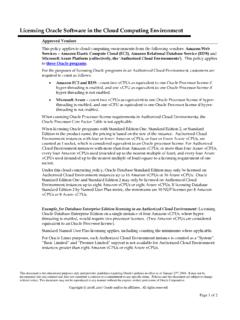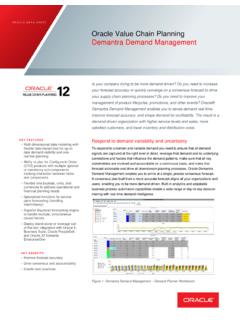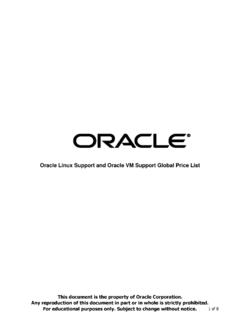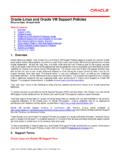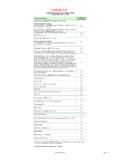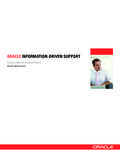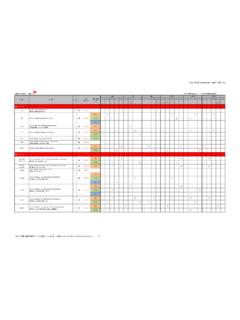Transcription of Transparent Role Transitions With Oracle Data …
1 1 | Oracle GOLDENGATE PERFORMANCE BEST PRACTICES Transparent Role Transitions with Oracle Data Guard and Oracle GoldenGateO R A C L E W H I T E P A P E R | F E B R U A R Y 2 0 1 5 ICES Transparent Role Transitions with Oracle Data Guard and Oracle GoldenGate 2 | Oracle GOLDENGATE PERFORMANCE BEST PRACTICES Table of Contents Introduction 3 MAA Architecture Examples with Oracle GoldenGate and Oracle Active Data Guard 5 Configuring DBFS for Oracle GoldenGate Shared Files 7 Oracle GoldenGate Integrated Capture 8 Oracle Data Guard Failover with Data Loss Considerations 9 Oracle GoldenGate Data Pump 11 Oracle GoldenGate Replicat 11 Oracle Data Guard Failover with Data Loss Considerations 12 Oracle GoldenGate Manager 12 Oracle Cluster Resource (CRS) Configuration 12 Create the Oracle Clusterware Role-Based Service for Oracle GoldenGate 13 Create the DBFS Resource 14 Create Oracle GoldenGate Application Virtual IP (VIP) Address If Using Oracle RAC 15 Oracle Grid Infrastructure Agent Configuration 15 Conclusion 18 Appendix.
2 Oracle GoldenGate Configuration Without the Oracle Grid Infrastructure Agent 19 Database Configuration for Automatic DBFS Mounting and Unmounting 19 Oracle GoldenGate Data Pump Configuration and Role Transitions 23 3 | Oracle GOLDENGATE PERFORMANCE BEST PRACTICES Introduction To achieve the highest levels of availability resulting in zero or near-zero downtime for both unplanned outages and all planned maintenance activities, customers frequently use the combination of Oracle Active Data Guard ( Oracle ADG) and Oracle GoldenGate. Oracle Data Guard provides zero data loss failover, comprehensive data protection and very fast failover for database failures, cluster failures and data corruptions. Using Oracle Active Data Guard offers the additional benefit of being able to open the standby database in read-only mode, allowing queries to return results that are identical to what would be returned from the primary database.
3 The other significant Oracle Active Data Guard HA benefit is auto block repair for physical block corruptions. Oracle GoldenGate provides advanced replication features, including bi-directional replication used to facilitate zero downtime planned maintenance, migrations, and for database and application upgrades. Oracle Active Data Guard and Oracle GoldenGate are essential components of the Gold and Platinum MAA reference architectures as described in Oracle MAA Architecture The Foundation for Database as a Service and the Oracle Database 12c High Availability Overview guide. This Maximum Availability Architecture (MAA) best practices paper describes the configuration best practices to enable Oracle GoldenGate replication using a database that is protected by a Data Guard standby to transparently and seamlessly work following an Oracle Data Guard role transition , no matter which Data Guard protection mode is configured (Maximum Performance, Availability or Protection).
4 The key prerequisites are: An Oracle GoldenGate database that is a source or target database for Oracle GoldenGate replication that is protected with Oracle Data Guard or Oracle Active Data Guard. The Oracle GoldenGate database can have a subset of or all of the following Oracle GoldenGate components running against it: Extract, Data Pump and Replicat. This is only applicable for Oracle Database 11g and later releases using Oracle Data Guard or Oracle Active Data Guard with physical standby databases. Oracle Grid Infrastructure 11g Release 2 ( ) or later. Oracle Grid Infrastructure provides the necessary components needed to manage high availability for any business-critical applications. Using Oracle Clusterware (a component of 4 | Oracle GOLDENGATE PERFORMANCE BEST PRACTICES Oracle Grid Infrastructure) network, database and Oracle GoldenGate resources can be managed to provide availability in the event of a failure.
5 Oracle Grid Infrastructure Agent version or later. The Oracle Grid Infrastructure Agent leverages the Oracle Grid Infrastructure components to provide integration between Oracle GoldenGate and its dependent resources, such as the database, network and file system. The agent also integrates Oracle GoldenGate with Oracle Data Guard so that Oracle GoldenGate is restarted on the new primary database following a role transition . Oracle Database 11g Release 2 ( ) or later. Use Oracle Database 11g Release 2 ( ) or later to take advantage of Oracle GoldenGate integrated Extract and integrated Replicat features. Refer to My Oracle Support Note for a full list of recommended Oracle database patches when using Oracle GoldenGate. Oracle GoldenGate version or later.
6 Use Oracle GoldenGate Extract in integrated capture mode deployed locally. Oracle also recommends using Oracle GoldenGate integrated Replicat, available with Oracle Database 11g Release 2 ( ) or later. Oracle DBFS to protect and replicate critical GoldenGate files. The Oracle Database File System (DBFS) is the only MAA validated and recommended file system because it allows the storage of the important Oracle GoldenGate files, such as the checkpoint and trail files, to be located inside the same database that is protected with Oracle Data Guard, ensuring consistency between the Oracle GoldenGate files and the database. A DBFS disk group is also pre-configured with Oracle Exadata Database Machines. Oracle highly recommends using Oracle Clusterware and the Oracle Grid Infrastructure Agent to simplify and automate the integration of Oracle GoldenGate and Oracle Data Guard.
7 If you cannot use Oracle Clusterware and the Oracle Grid Infrastructure Agent, refer to the instructions provided in the Appendix of this paper. For all generic MAA and Oracle GoldenGate MAA best practices, refer to the following URL: 5 | Oracle GOLDENGATE PERFORMANCE BEST PRACTICESMAA Architecture Examples with Guard For some, an active-active HA database architecture is required to take advantage of the unplanned and planned maintenance advantages with Oracle GoldenGate. However, Oracle GoldenGate alone cannot guarantee zero data loss in the case of database, cluster or data corruptiarchitectures illustrated in the following figures are suggested. Figure 1: Example Architecture 1In Figure 1, when executing a failover or switchover to the physical standby database, the Extract and Target databases work seamlessly after the Guard standby database is the primary failover target in case Data Guard is read-only and active, but all application transactions that contain DMLs or DDLs must be redirected to the primary database.
8 The Oracle GoldenGate maintenance activities, such as an application with Oracle GoldenGate and Oracle Active Data active HA database architecture is required to take advantage of the unplanned and planned maintenance advantages with Oracle GoldenGate. However, Oracle GoldenGate alone cannot guarantee zero data loss in the case of database, cluster or data corruption failures. To protect against these types of failures, the MAA are suggested. Figure 1: Example Architecture 1 Figure 1, when executing a failover or switchover to the physical standby database, the Oracle GoldenGatework seamlessly after the Oracle Data Guard role transition . The Oracle Activefailover target in case there are database or cluster failures. Oracle Activeonly and active, but all application transactions that contain DMLs or DDLs must be redirected to target database is used to mitigate the downtime for planned such as an application upgrade.
9 Oracle GoldenGate and Oracle Active Data active HA database architecture is required to take advantage of the unplanned and planned maintenance advantages with Oracle GoldenGate. However, Oracle GoldenGate alone cannot guarantee zero data on failures. To protect against these types of failures, the MAA Oracle GoldenGate Oracle Active Data Oracle Active only and active, but all application transactions that contain DMLs or DDLs must be redirected to 6 | Oracle GOLDENGATE PERFORMANCE BEST PRACTICESF igure 2: Example Architecture 2In Figure 2, the two primary databases are replicating data between each other using Oracle can be uni-directional or bi-directional. When data loss cannot be tolerated, fast-start failover configured in maximum availability each Oracle GoldenGate database.
10 When fast-observer determines if a failover is necessary and initiates the failover to the specified standby database automatically, with no need for DBA intervention. Afterreplication will continue to work seamlessly. Figure 2 depicts Oracle GoldenGate being active on the primary database. The postshows that Oracle GoldenGate has been re-enabled on the new primary database ICES Figure 2: Example Architecture 2 Figure 2, the two primary databases are replicating data between each other using Oracle GoldenGate. The data directional. When data loss cannot be tolerated, Oracle Active Data Guard start failover configured in maximum availability or maximum protection mode (SYNC transport) is configured for -start failover is enabled, the Oracle Data Guard broker and its observer determines if a failover is necessary and initiates the failover to the specified standby database automatically, with no need for DBA intervention.
